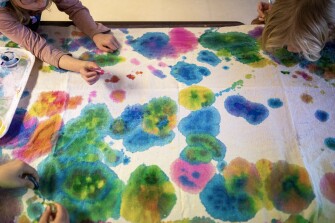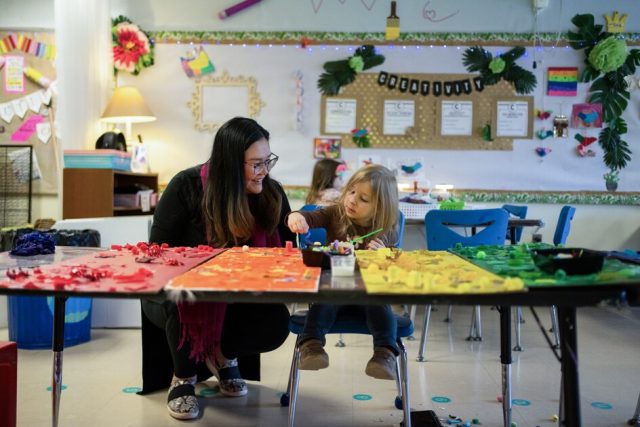[ad_1]
Teaching strategies come and go in K-12 education. But in the ever-evolving quest to find the best way to teach elementary-age students the core skills they need to master before moving on to more advanced grades, one factor remains consistent: students learn best when they’re motivated.
While some students come to school self-motivated and ready to learn, others seem to lack the same degree of drive. But there’s a lot teachers can do to keep the spark alive among their most self-motivated students, and to ignite it in others.
Education Week sought input from a mix of experts—educational researchers and classroom teachers recognized for their excellence—on strategies to facilitate motivation in the youngest students for long-term academic success.
Here’s what we learned:
1. Give students more control, even the youngest learners
Kim King teaches art to K-4 students in the Mansfield Public Schools in Storrs Mansfield, Conn. She’s found that giving students more control over what they do in her classes motivates them to try harder.
“A couple of years ago, I started to gradually switch my approach from that of a traditional art teacher, where I’d assign a project for the students,” said King, who was recognized in 2022 as Connecticut’s Teacher of the Year.
She estimated that about half of her students demonstrated self-motivation under the traditional approach. “For the others, I was doing a lot of scaffolding, re-directing, re-engaging them in the project,” she said. “I was pulling the second half of my class along.”
King used to teach art to high school students, most of whom choose to take art as an elective and wanted to be there. That difference is key to student motivation, she said. So, King started to look into ways to give her elementary students, who were required to take her class, more choices.
“We started to talk about what it’s like to be an artist, how [students] develop ideas. I started to see more engagement and self-motivation,” King said. “I began to realize that my focus was building creative confidence so my students could trust their own ideas.”
For example, King’s 4th grade students created self-portraits, with a twist. They traced their silhouettes, and from there came choices.
“They could do anything that showed something personal,” said King. Some students chose to use collages, others drew, some painted. “Everybody felt successful … That’s where you’re going to get that motivation.”
Giving students more control doesn’t mean that the teacher is giving up control, King emphasized.
“It’s not a free-for-all. They’re learning skills. But they have a voice,” she said.
2. Foster students’ belief in their own abilities
Also essential to motivation is the belief in one’s ability to master a given project or problem.
Most of King’s former high school students decided well before they reached her class whether or not they were “good at” art, King said. She found that her students who believe they don’t possess artistic strengths usually exhibit less self-motivation to pursue artistic projects than their peers who do.
“Kids have to feel like they’re capable of accomplishing the work at least at some level,” said Allan Wigfield, professor emeritus at the University of Maryland’s College of Education, who has co-authored numerous studies on reading and motivation in young readers.
Teachers can influence these feelings of capability to some extent, explained Wigfield, by making modifications to assignments for students who are struggling to help boost confidence. He uses the example of having teachers provide struggling readers with book selections they can master during periods reserved for independent reading.

Creating an environment conducive to facilitating that self-belief is important to Jessica Saum, a special education teacher in Cabot Public Schools, in northern Lonoke County, Ark.
“When we give students multiple ways to show us what they know, we’re not just meeting the needs of struggling students; we’re giving credence to the whole gamut of students’ brains,” said Saum, the 2022 Arkansas Teacher of the Year.
For instance, Saum said that if she is assessing spelling and not writing, she will allow a student who has difficulty with written expression to instead spell the word orally. Or she’ll let a student work with a partner on a project to demonstrate mastery.
3. Practice the ‘art of questioning’
Young children are innately curious. Cultivating that curiosity is key to enhancing students’ self-motivation, say experts. David Bell, the director of academic programs at Utah’s Western Governors University and a former K-12 teacher, refers to this skill as the art of questioning.
“As educators, it’s very valuable that we help students unpack and dissect what they’re learning,” said Bell.
Too often, said Bell, educators focus on having students summarize what they’ve learned as opposed to encouraging them to elaborate on concepts, which can occur even at the youngest grades through exploration of something as simple and concrete as a picture book. “As a teacher, I can ask: How do you know? Prove it.”
When teachers model this inquiry-based learning strategy, they encourage students to ask questions too.
“We have to cultivate early an environment where students ask ‘why,’” Bell said. “Create a culture where asking why is the norm.”
4. Model enthusiasm for learning
Teachers have enormous influence over their students—more than they may realize. Bell recounts a personal experience as a classroom teacher in Chicago that demonstrates this point.
“In the wintertime, I wouldn’t wear my shoes. I’d wear boots and carry my shoes,” he said. He soon noticed that many of his students began to do the same. “I didn’t realize they were trying to mimic my behavior.”
It makes sense, then, that students whose teachers demonstrate enthusiasm for their subject material are likely to feel the same way.
“My passion is reading. When you put emphasis and joy in that, and model that, [students’] motivation starts to build,” said Leah Porter, a 3rd grade teacher at Wilcox Elementary School in Holt, Mich.
Porter recalled how she built excitement for reading among her students, several of whom told her in the beginning of the year that they didn’t like to read. She began by sharing her own enthusiasm for reading and explained how she logs the books she reads for pleasure. Then she structured a readers’ workshop for her students, where they could choose what they read.
Initially, it took some time to generate enthusiasm among students who were reluctant to read. But that eventually changed.
“It’s been amazing to see how, just by me modeling the joy of reading and reading to them with the joy of intentionality … they get excited about it too,” said Porter, the 2022 Michigan Teacher of the Year. “Some students who were barely reading are now begging for more reading time.”
Teachers’ enthusiasm, whether or not aimed at a specific subject or lesson, is infectious for the youngest learners, Saum said. “There are a lot of students going to school every day looking for that teacher’s smile.”

5. Make fun a high priority
Making content fun adds another reason for students to want to learn. And that’s critical, especially for the youngest learners.
“The curriculum is a lot harder than it was 30 years ago. Expectations have risen to match the science of learning,” Saum said. “There is still play and fun, but we have kindergarteners who are reading and writing.”
Providing opportunities that connect academics to play increases students’ motivation, Saum said.
She uses the example of having students who are learning how to write practice writing words in shaving cream. It’s messy, but it’s an activity that most children will want to do. “They’re writing, which is hard, but this tactile stuff makes it fun and appealing,” Saum said.
[ad_2]
Source link











